Violets "Bullfight": description of the variety and the subtleties of cultivation
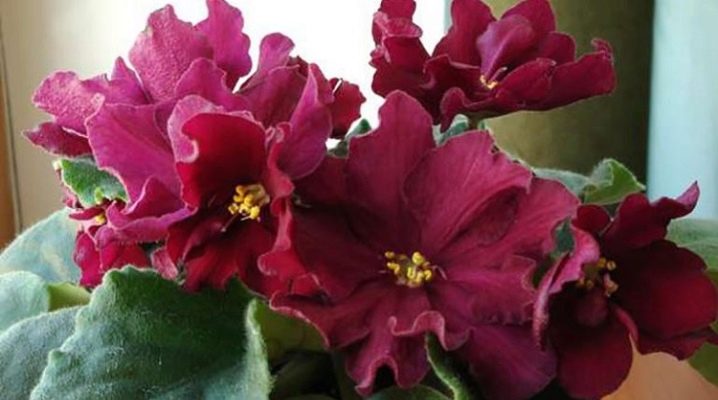
Few people know that the familiar word "violet" is the common name of Saintpaulia. Plants are decorative, therefore they often serve as decoration for home and office premises. One of the most interesting varieties of this indoor flower is Bullfight. Consider the intricacies of growing this variety.
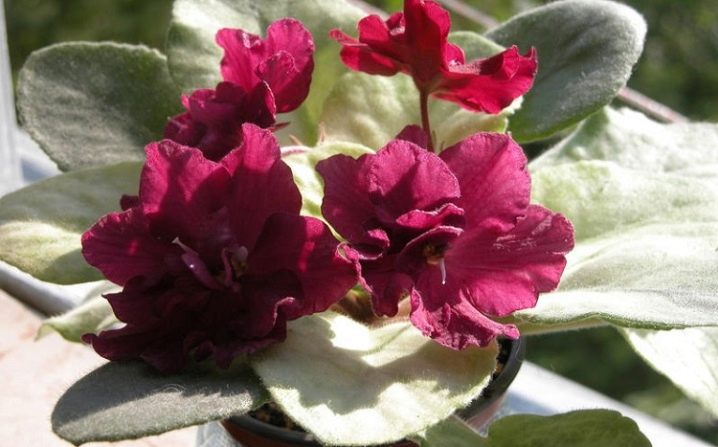
Description
The “EK-Boy of the Bulls Gold” variety stands out among others. It is a houseplant with rather large double star-shaped flowers of a rich "bloody" color. Depending on the nature of the lighting in the room, the violet pleases the eye with the most incredible shades. In bright light, the flowers turn bright scarlet, and in cloudy weather, they turn brown and ruby.
A distinctive feature of this variety is year-round flowering. First, the rosette throws out two or three low peduncles with a couple of buds on each. As soon as they begin to open, three more are formed. The result is a huge bouquet of flowers up to 8 cm in diameter.
The rosette of Saintpaulia is flat and rather dense. With proper care and timely fertilization, the plant reaches 30 cm in diameter. The leaf plates are large, slightly elongated, with a slight wavy edging. The color is deep green.

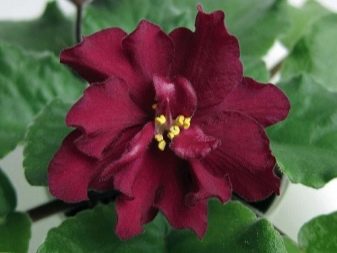
"Bullfight" is a capricious plant. Most flower growers note the instability of its flowering, and terry often appears only on the third cast of peduncles, although there are cases when the rosette gave a terry flower from the first time. In addition, the facts of the alternation of the quality of the flowers themselves between individual blooms are recorded.
Another unpleasant feature of this Saintpaulia is the frequent yellowing of the leaves in the bottom row. Often, the leaf plates located at the bottom of the rosette turn yellow and quickly die off after the next bud opens. Moreover, this process does not depend in any way on the level of illumination, temperature and irrigation characteristics. It also does not mean that the plant has encountered a disease. It's just the nature of Bullfight Saintpaulia.
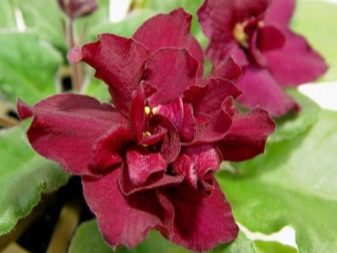
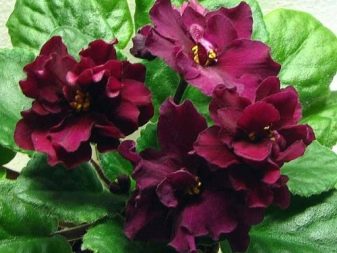
Optimal conditions
Saintpaulias of this variety are usually kept under artificial light, as well as on windows located from the north, north-east or north-west. This variety does not tolerate direct sunlight, but at the same time, it needs illumination for 12-15 hours a day, therefore, the deficit of natural insolation must be compensated for with special phytolamps or fluorescent lamps of the yellow spectrum. If the saintpaulia is placed on a window, then it must be turned in different directions towards the window 2-3 times a day. Thanks to this, the rosette is formed symmetrical and neat.
The optimum room temperature is 18-25 degrees. The flower does not tolerate frequent drafts and low temperatures. The humidity level should be maintained at a level of 50-60%, however, it is not recommended to increase it artificially by spraying the plant. It is better to turn on a humidifier or at least a room fountain for several hours a day. If neither one nor the other is in the house, you can occasionally spray water from a spray bottle at a distance of 1.5-2 meters from the flower.
It will not be superfluous to place a small container of water next to the green "pet".
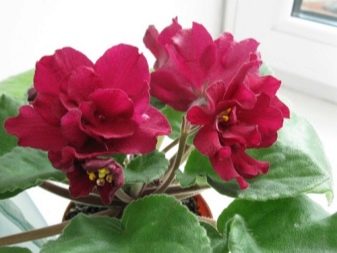
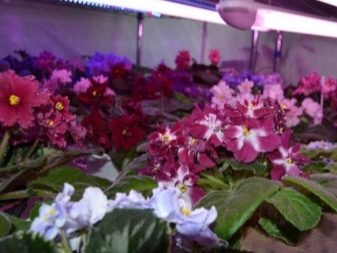
Subtleties of care
In order for the violet to please its owners with abundant and bright flowering all year round, it is required to carry out constant feeding and regular watering.The plant should be irrigated whenever the potted soil is about a third dry. For irrigation, you should use soft, settled water, always at room temperature. The liquid should be poured evenly under the spine, preventing moisture from entering the sheet plates. Otherwise, the leaves change color and even begin to rot.
Experienced flower growers advise to organize watering "Bullfight" in one of the following ways:
- upper - in this case, a watering can with an elongated spout is used;
- lower - in this case, the container with the plant is placed in a basin filled with water by 2/3, and left in this position for half an hour so that water penetrates into the peas through the drainage holes;
- wick - with this option, the flower itself regulates the water level in the substrate, gradually pulling it along the cord-wick: one end of it is placed in a container with water, and the other is lowered into the ground.
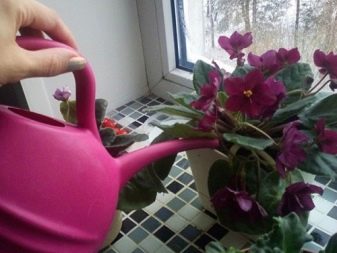
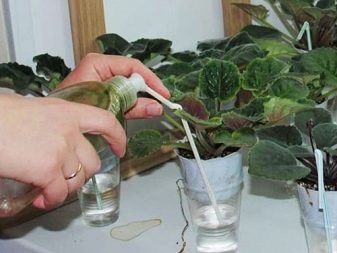
Every 10-15 days after watering, the plant is fertilized. At the time of growing green mass, the flower needs nitrogen, at the stage of bud formation and at the stage of flowering, it is better to use fertilizing with phosphorus and potash complex fertilizers. Keep in mind that only healthy flowers with a developed root system should be watered. If the plant is transplanted or has been ill, then feeding should be interrupted for 2 months.
Remember to remove dust from the flower every month. To do this, he is given a warm shower, and then allowed to dry and returned to a permanent place.
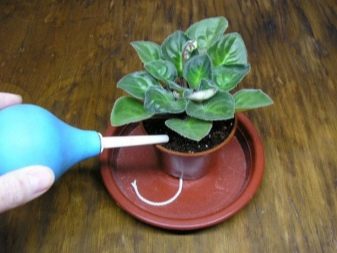
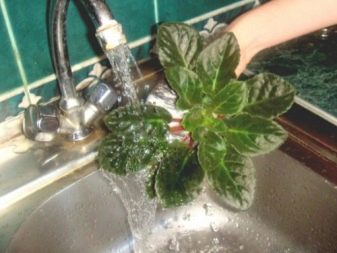
Transfer
Every spring, the bullfight violet is transplanted into a fresh substrate. To do this, take soil for Saintpaulias (it can be purchased in the store) or make it up yourself from peat, river sand, leaf, coniferous, and turf soil. To make the substrate looser, add 10-15% perlikt to it.
For seating, it is better to take low, but wide pots. The fact is that the root system of Saintpaulia is superficial, so deep soil layers that have not been mastered by the roots begin to acidify. The optimal diameter of the pot is 10-15 cm. If the container is more voluminous, then the violet will not bloom until the root system fills the entire space, and this can be expected up to 2-3 years. The bottom of the pot should certainly be laid out with pebbles or expanded clay for arranging the drainage layer. It will remove excess moisture from the root system, thereby preventing rotting.
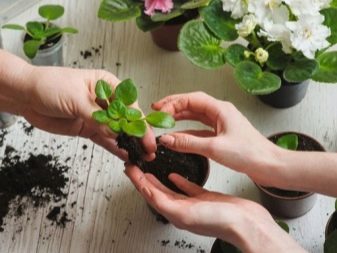
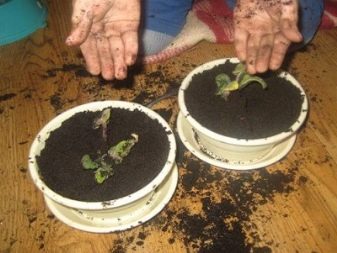
Diseases and pests
The best prevention of infection of Saintpaulia with bacterial and fungal infections is compliance with the standards of flower care and the creation of optimal conditions for its growth and development. Competent watering, fertilizing, following the transplant technology help to increase the immunity of the flower and increase its ability to resist dangerous viruses and other pathogenic microorganisms.
If the plant is waterlogged, in a lack of light, or in a room that is too cold, then it quite often becomes a victim of powdery mildew, late blight or all kinds of rot. In the earliest stages, the flower can still be saved. To do this, you need to completely remove all affected parts of the plant, and then transplant the Saintpaulia into a new container with fresh substrate.
After transplanting, the flower must be treated with a fungicidal solution.
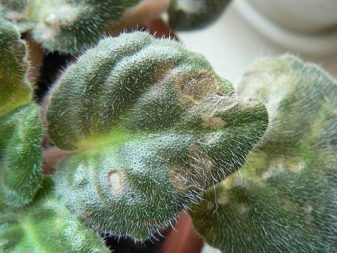
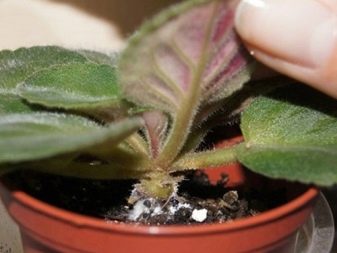
The following insect pests pose the greatest danger to the "Fight of the Bulls" violets:
- spider mite;
- shield;
- aphid;
- thrips;
- nematode.
If insects are found, it is necessary to immediately wash the plant with a solution of laundry soap, and then treat it with an antibacterial composition. The most effective drugs are Fitoverm, Actellik and Fufanon.
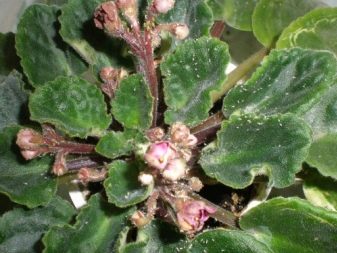
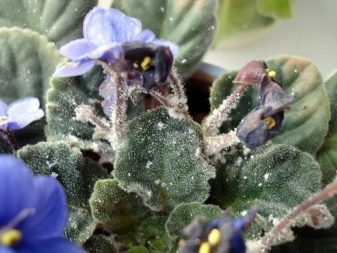
Reproduction
Saintpaulia "Bullfight" is propagated by seeds, stepsons or cuttings. The first method is considered rather troublesome and time-consuming, therefore, it is mainly used by breeders to develop new varieties. At home, other vegetative methods are available to flower growers.The most common grafting.
For reproduction of violets, a stalk taken from the second row of a full-fledged flower rosette is used. To do this, a neat oblique cut is made 3-5 cm from the base of the sheet plate with pruning shears. The sprout is placed in a vessel with water at room temperature. To prevent root decay, the substrate is slightly stained with methylene blue solution or an activated carbon tablet is added. As soon as a root of 1.5-2 cm appears, you can transplant the plant into the ground. As a rule, babies appear after a month.
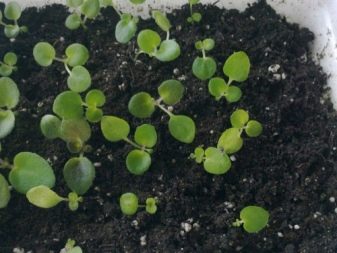
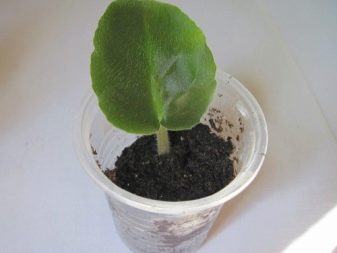
The second breeding option for Saintpaulia "Bullfight" is with rosettes-stepsons. It should be noted that this type of violets practically does not give stepchildren, so their appearance must be stimulated. To this end, the dew point is gently pinched at the outlet. At this moment, the plant turns on the "instinct of self-preservation", it begins to intensively release new sockets, and daughter ones are already being formed from them. When the length of the stepsons reaches 3 cm, they can be separated from the small flower and planted in separate containers.
At first, a young plant must be kept in greenhouse conditions. To do this, the stepsons are covered with a plastic cup or bag and wait for the appearance of young leaves. Then the insulating "cap" is removed.
When the plant produces 4-5 new leaves, it can be transplanted into a permanent pot.
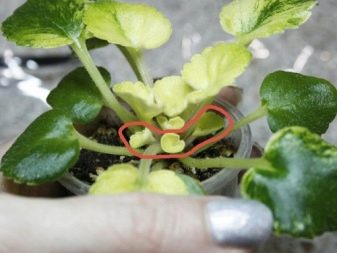

You can watch an overview of the violet "Bullfight" in the video below.































The comment was sent successfully.